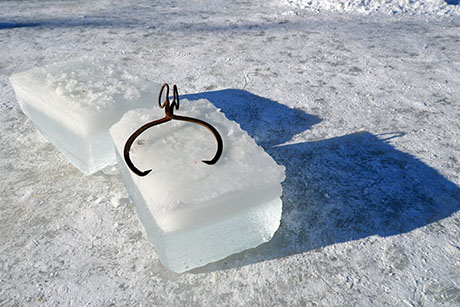
IMAGE: A block of Thompson Lake Ice, hauled onto the surface with tongs. All photographs by Nicola Twilley.
In 1805, a twenty-three year-old Bostonian called Frederic Tudor launched a new industry: the international frozen-water trade.
Over the next fifty years, he and the men he worked with developed specialised ice harvesting tools, a global network of thermally engineered ice houses, and a business model that cleverly leveraged ballast-less ships, off-season farmers, and overheated Englishmen abroad. By the turn of the century, the industry employed 90,000 people and was worth $220 million in today’s terms.
By 1930, it had disappeared, almost without trace, replaced by an artificial cryosphere of cold storage warehouses and domestic refrigerators.
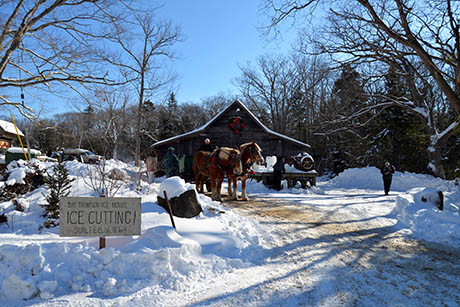
IMAGE: The Thompson Ice House Annual Ice Cutting includes a pair of Clydesdales.
There are only a handful of places left in the United States that still practice the forgotten art of harvesting winter. A couple of weeks ago, I visited South Bristol, Maine, to take part in the annual ice cutting at the Thompson Ice House, a small wooden shack by the side of State Route 129 that claims to be “the only commercial ice house on the National Register of Historic Places to have stored naturally frozen ice harvested in the traditional way from a nearby pond.”
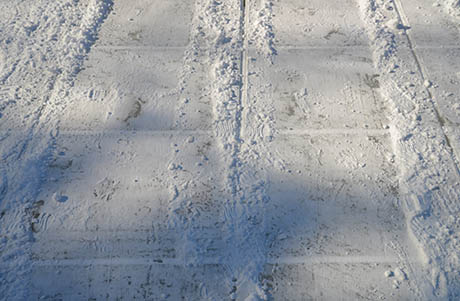
IMAGE: Scored grid on the lake surface.
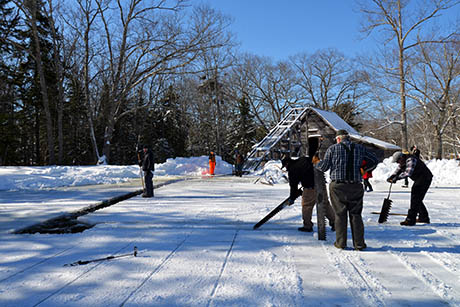
IMAGE: Cutting the first raft.
When I arrived, several older men in worn overalls and plaid had already etched an oblong grid on the snow-dusted surface of the lake using an ice plough, leaving ghostly outlines of white rectangles stretching into the distance like some kind of 2D Continuous Monument. Ken Lincoln, the President of the Thompson Ice House Preservation Corporation, was firing up an early nineteenth-century gas-powered saw to carve out the channel leading to the ice house ramp. As the last owner of the commercial ice operation at Thompson Ice House, Lincoln had kept it running for half a century after the rest of the New England ice industry had vanished from the landscape. He finally got out of the frozen water business in 1985, re-opening the ice house as a working museum five years later.

IMAGE: A small room to the side of the ice house serves as a museum. The window offers a view onto the sawdust insulation around the ice.
Inside the ice house, a couple of layers of ice blocks already glowed blue-white. They had been harvested a week earlier at the bidding of a Discovery Channel film crew. Ice, it seems, is hot this winter: Lincoln mentioned that National Geographic was coming to film later in the month, and, during my visit, an excitable woman was attaching a GoPro camera to a pike pole in order to capture footage for a forthcoming Timberland advertising campaign.
Gradually, without any formal announcement or fanfare, the day’s harvest got underway, using a collection of found and donated antique tools. Working in pairs, the men cut along parallel scored lines using heavy, two-handled ice saws. When the long rectangular raft floated free, they grabbed long-handled chisel-like tools called breaker bars, which, when dropped on the scored lines, broke the blocks up cross-wise. Finally, they steered each individual cake into the ice-house channel, using a pike pole to gently nudge and drag the slow-moving white cuboids through narrow band of black water.
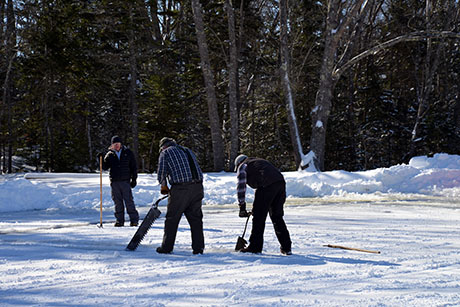
IMAGE: Sawing the first raft.
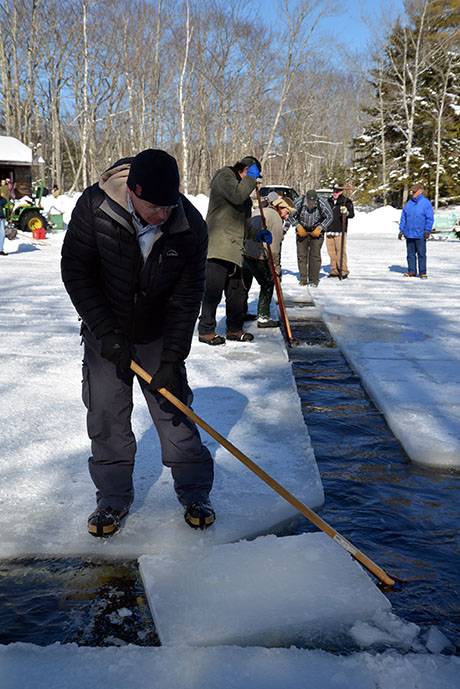
IMAGE: Guiding the ice cakes into the ice house channel with a pike pole.
After the initial row had been harvested, as a sort of low-key demonstration, it was open season on the tools: everyone was free to try their hand at sawing, breaking, and steering the ice. I can report that sawing was the quickest way to warm up — dragging the unwieldy iron blades through twelve inches of ice was quite a workout. Steering was also surprisingly tricky: the cakes weigh more than 300 lbs each, and move through the water with the slow solidity of a container ship. Snapping individual blocks off the longer raft using the breaker bar was, however, a highly satisfying experience — one correctly positioned thrust, and, with a gentle crack, a newly carved block emerged in all its crystalline perfection.
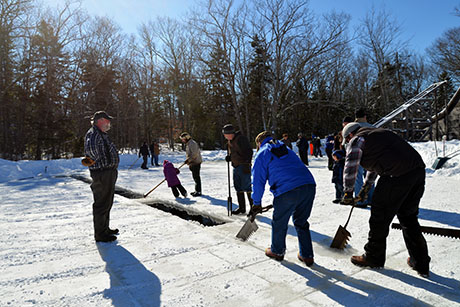
IMAGE: Sawing and steering.
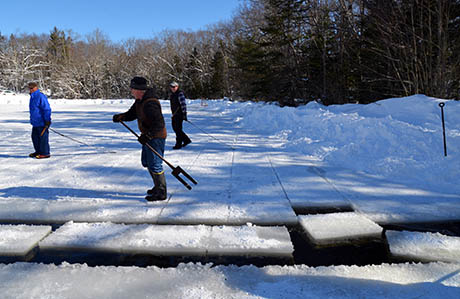
IMAGE: Wielding a breaker fork.
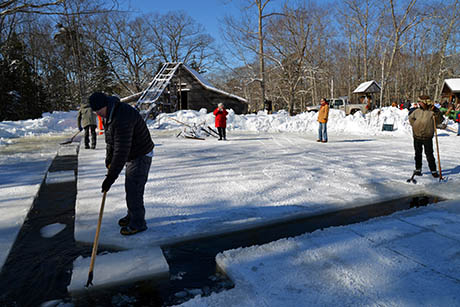
IMAGE: Guiding the first blocks through the channel.
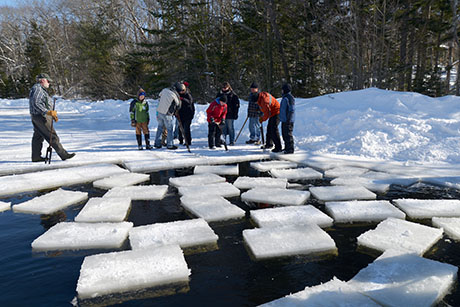
IMAGE: An ice-block jam.
The business of getting the harvested ice into the ice house was a little less amateur-friendly. A pair of older guys in fluorescent fishing waterproofs dunked the ice cakes to sit them on a sled attached to a pulley system. The horsepower was provided by an ancient man in a battered pick up truck, rather than actual Clydesdales (which were, instead, giving rides to local kids). Once the dunkers raised their arms, the pick up driver reversed, and the glistening, translucent, oversized ice cube was hauled on a ramp to the top of a rickety wooden scaffold, where it paused for a brief moment, scattering rainbows in all directions like a giant prism, before picking up speed on its slide down into the ice house.
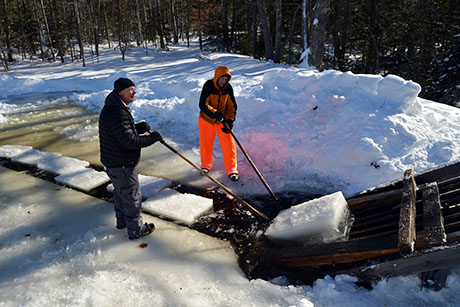
IMAGE: Loading the ice cake onto the sled.
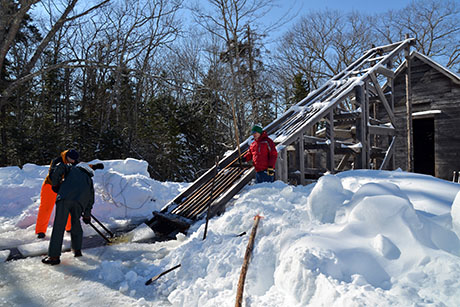
IMAGE: Ice house ramp and pulley system.
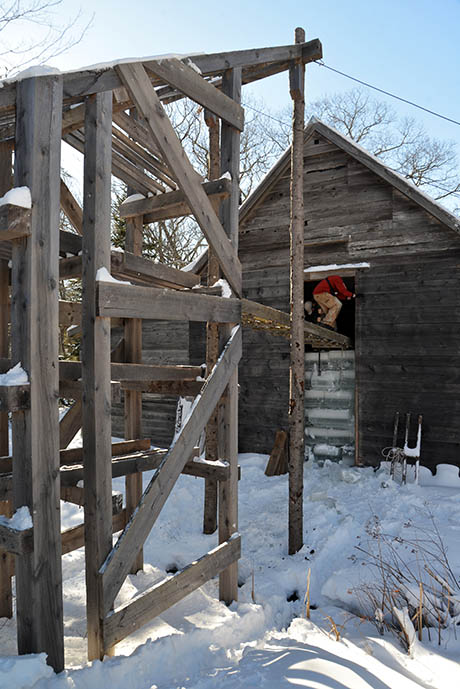
IMAGE: The ramp slopes down into the ice house.
Inside the ice house, the younger generation performed the slightly more hair-raising work of positioning the cakes. As the ice block paused for a moment, at the top of its ascent, someone would shout “ice inbound,” and, in a kind of combination of curling and Tetris played using only pike poles, the wranglers would crouch, ready to guide the heavy block, sliding fast on its icy undercarriage, into the next open slot.
Sometimes it worked, and the block accelerated into its slot with a satisfying thunk. Mostly, it did not, and the speeding ice cake careened off course, crashing into walls, chipping chunks off other blocks in a sparkling spray, and, sometimes, the old timers told me, breaking ankles.
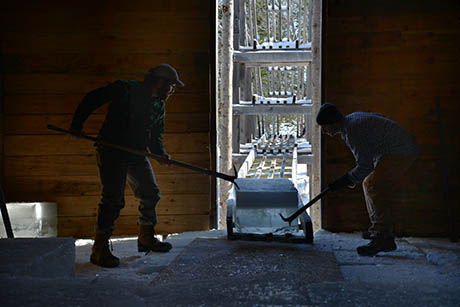
IMAGE: Ice inbound!
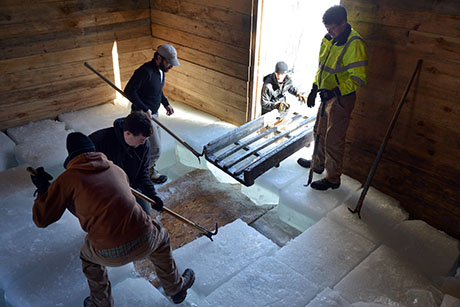
IMAGE: Wrangling the ice blocks.
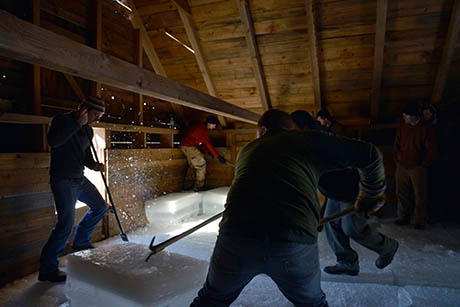
IMAGE: Each ice cake weighs more than 300 lbs and is travelling at speed, making wrangling a sport for the nimble.
It looked like a lot of fun as I watched from above, perched on a ladder and peaking through a ventilation window, but my nerve was depleted after a panic-inducing drive through a winter storm to reach the pond. Next year, maybe…
The ice house itself is an interesting architectural technology. As Gavin Weightman writes, in his highly recommended history, The Frozen-Water Trade, nineteenth-century ice entrepreneurs knew that “there was no way of preventing ice from melting once the air temperature rose above freezing; it was a matter of finding how best to slow down the inevitable thaw.”
It was not enough to protect the ice from the warm air around it, for the interior of an icehouse has complex atmosphere of its own.
Before Frederic Tudor industrialized the frozen water business, wealthy landowners in Europe and North America had built underground, stone- or brick-lined ice houses on their estates in order to be able to enjoy delicate ices and jellies in the height of summer. Tudor’s first ice house, in Havana, Cuba, was completely different: entirely above ground, and built of wood, with a layer of sawdust between double walls as insulation.
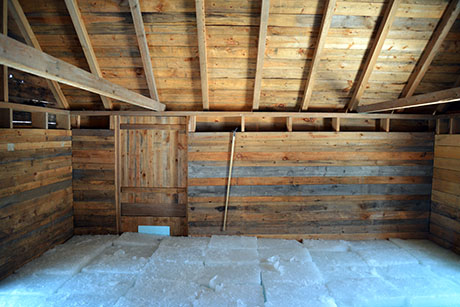
IMAGE: The ice house half-full, as we broke for lunch (truly excellent homemade chilli and whoopie pies).
This revolutionary model, with a pitched roof to provide adequate ventilation, worked rather well, limiting shrinkage to less than twenty-five percent. It soon caught on across America’s ice belt, from Pennsylvania to Maine. Indeed, by the end of the nineteenth century, no New England pond or lake was without one. But the wooden structures have a tendency to either burn or fall down — as the ice melts and shifts slowly over the summer, they sag, leaning ever further southward — and, as the ice trade dried up, its storage infrastructure vanished, too.
Even the Thompson Ice House is actually a reconstruction, built on the same site, to the same plan, and from the salvaged materials of the original ice house, which, after 150 years of service, was in rather a dilapidated state.
Its steeply pitched roof helps dissipate the rising heat, and a subterranean drain deals with meltwater, so that, carefully packed, the ice lasts through the summer. These days, however, the Thompson ice is mostly used up in one epic burst: a July ice cream social, open to all, but undoubtedly most heartily enjoyed by those who worked to store the cold five months earlier.
Otherwise, the ice is sold, a dollar a cake on the honour system, to sport fishermen. With fewer air bubbles, natural ice melts more slowly than the artificial kind, and a good block will apparently last up to a week out on the water.
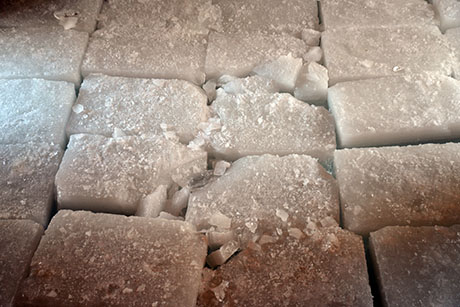
IMAGE: The more tightly the ice is packed, the longer it lasts, so broken chunks are used to patch any gaps.
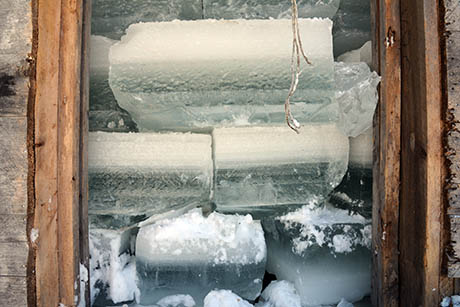
IMAGE: Packed ice from the side. The white snow ice is of lesser quality and melts more quickly.
At its peak, at the end of the nineteenth century, the frozen-water trade kept a rapidly urbanising America fed and watered. Cakes of natural ice were the refrigerant in Gustavus Swift’s pioneering rail shipments of slaughtered meat, in the Great White Fleet’s banana boats, and in the breweries set up by new German immigrants, enabling them to make lager beer all year round. Funnily enough, despite being a thriving industry, it barely figures in official statistics: as Gavin Weightman explains, “since it could be classified as neither mining nor farming, it was not subject to any taxes that would have given federal or state governments an interest in it.”
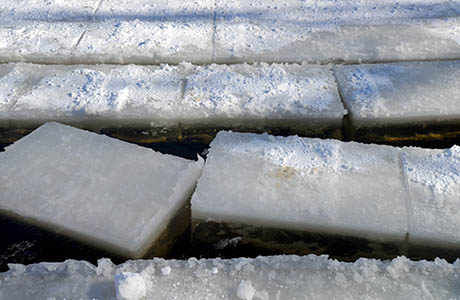
IMAGE: Ice cakes floating in the channel.
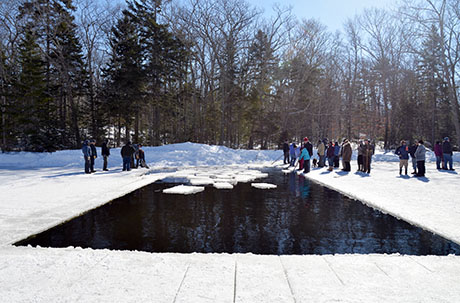
IMAGE: A harvested rectangle.
Although it’s hard to imagine the commercial natural ice industry ever competing with its artificial rival again, I left my day of ice harvesting convinced that, providing climate change does not rule it out, a local, small-scale revival of the frozen-water trade would be a very good thing. For one thing, it forces communities to pay attention to the water quality in their local lakes and ponds. Then there’s the fact that ice harvesting is an inherently communal activity that brings together neighbours and strangers alike. And, if even small parts of the local food system can use the freely provided bounty of winter where possible, rather than its the electricity-hungry artificial counterpart, that can’t help but increase resiliency overall.
Besides, what better way to demonstrate the central role that cold plays in our contemporary lives than by experiencing the enormous physical effort once expended to achieve it?

